[English] 日本語
 Yorodumi
Yorodumi- PDB-6pa1: Killer cell immunoglobulin-like receptor 2DL2 in complex with HLA... -
+ Open data
Open data
- Basic information
Basic information
| Entry | Database: PDB / ID: 6pa1 | ||||||
|---|---|---|---|---|---|---|---|
| Title | Killer cell immunoglobulin-like receptor 2DL2 in complex with HLA-C*07:02 | ||||||
 Components Components |
| ||||||
 Keywords Keywords | IMMUNE SYSTEM / KIR receptor / HLA / innate immunity / NK cell / T cell | ||||||
| Function / homology |  Function and homology information Function and homology informationimmune response-regulating signaling pathway / TAP binding / antigen processing and presentation of endogenous peptide antigen via MHC class Ib / antigen processing and presentation of endogenous peptide antigen via MHC class I via ER pathway, TAP-independent / Chromatin modifying enzymes / telomere organization / Interleukin-7 signaling / RNA Polymerase I Promoter Opening / epigenetic regulation of gene expression / Assembly of the ORC complex at the origin of replication ...immune response-regulating signaling pathway / TAP binding / antigen processing and presentation of endogenous peptide antigen via MHC class Ib / antigen processing and presentation of endogenous peptide antigen via MHC class I via ER pathway, TAP-independent / Chromatin modifying enzymes / telomere organization / Interleukin-7 signaling / RNA Polymerase I Promoter Opening / epigenetic regulation of gene expression / Assembly of the ORC complex at the origin of replication / negative regulation of receptor binding / secretory granule membrane / Regulation of endogenous retroelements by the Human Silencing Hub (HUSH) complex / early endosome lumen / Nef mediated downregulation of MHC class I complex cell surface expression / DAP12 interactions / DNA methylation / Condensation of Prophase Chromosomes / Chromatin modifications during the maternal to zygotic transition (MZT) / SIRT1 negatively regulates rRNA expression / HCMV Late Events / transferrin transport / ERCC6 (CSB) and EHMT2 (G9a) positively regulate rRNA expression / cellular response to iron ion / PRC2 methylates histones and DNA / Endosomal/Vacuolar pathway / Regulation of endogenous retroelements by KRAB-ZFP proteins / Defective pyroptosis / Antigen Presentation: Folding, assembly and peptide loading of class I MHC / HDACs deacetylate histones / Regulation of endogenous retroelements by Piwi-interacting RNAs (piRNAs) / peptide antigen assembly with MHC class II protein complex / lumenal side of endoplasmic reticulum membrane / RNA Polymerase I Promoter Escape / cellular response to iron(III) ion / MHC class II protein complex / negative regulation of forebrain neuron differentiation / antigen processing and presentation of exogenous protein antigen via MHC class Ib, TAP-dependent / Transcriptional regulation by small RNAs / ER to Golgi transport vesicle membrane / peptide antigen assembly with MHC class I protein complex / regulation of iron ion transport / regulation of erythrocyte differentiation / HFE-transferrin receptor complex / response to molecule of bacterial origin / MHC class I peptide loading complex / Formation of the beta-catenin:TCF transactivating complex / Activated PKN1 stimulates transcription of AR (androgen receptor) regulated genes KLK2 and KLK3 / RUNX1 regulates genes involved in megakaryocyte differentiation and platelet function / HDMs demethylate histones / T cell mediated cytotoxicity / positive regulation of T cell cytokine production / antigen processing and presentation of endogenous peptide antigen via MHC class I / antigen processing and presentation of exogenous peptide antigen via MHC class II / positive regulation of immune response / NoRC negatively regulates rRNA expression / MHC class I protein complex / positive regulation of T cell activation / peptide antigen binding / positive regulation of receptor-mediated endocytosis / negative regulation of neurogenesis / B-WICH complex positively regulates rRNA expression / PKMTs methylate histone lysines / cellular response to nicotine / positive regulation of T cell mediated cytotoxicity / multicellular organismal-level iron ion homeostasis / Pre-NOTCH Transcription and Translation / Meiotic recombination / specific granule lumen / Activation of anterior HOX genes in hindbrain development during early embryogenesis / RMTs methylate histone arginines / phagocytic vesicle membrane / Transcriptional regulation of granulopoiesis / recycling endosome membrane / Interferon gamma signaling / Immunoregulatory interactions between a Lymphoid and a non-Lymphoid cell / negative regulation of epithelial cell proliferation / HCMV Early Events / MHC class II protein complex binding / Interferon alpha/beta signaling / Modulation by Mtb of host immune system / structural constituent of chromatin / late endosome membrane / sensory perception of smell / positive regulation of cellular senescence / tertiary granule lumen / DAP12 signaling / nucleosome / T cell differentiation in thymus / nucleosome assembly / negative regulation of neuron projection development / HATs acetylate histones / RUNX1 regulates transcription of genes involved in differentiation of HSCs / Factors involved in megakaryocyte development and platelet production / ER-Phagosome pathway / MLL4 and MLL3 complexes regulate expression of PPARG target genes in adipogenesis and hepatic steatosis / chromatin organization / protein refolding / Senescence-Associated Secretory Phenotype (SASP) / early endosome membrane Similarity search - Function | ||||||
| Biological species |  Homo sapiens (human) Homo sapiens (human)synthetic construct (others) | ||||||
| Method |  X-RAY DIFFRACTION / X-RAY DIFFRACTION /  SYNCHROTRON / SYNCHROTRON /  MOLECULAR REPLACEMENT / Resolution: 3.01 Å MOLECULAR REPLACEMENT / Resolution: 3.01 Å | ||||||
 Authors Authors | Moradi, S. / Rossjohn, J. / Vivian, J.P. | ||||||
 Citation Citation |  Journal: Nat Commun / Year: 2021 Journal: Nat Commun / Year: 2021Title: Structural plasticity of KIR2DL2 and KIR2DL3 enables altered docking geometries atop HLA-C. Authors: Moradi, S. / Stankovic, S. / O'Connor, G.M. / Pymm, P. / MacLachlan, B.J. / Faoro, C. / Retiere, C. / Sullivan, L.C. / Saunders, P.M. / Widjaja, J. / Cox-Livingstone, S. / Rossjohn, J. / ...Authors: Moradi, S. / Stankovic, S. / O'Connor, G.M. / Pymm, P. / MacLachlan, B.J. / Faoro, C. / Retiere, C. / Sullivan, L.C. / Saunders, P.M. / Widjaja, J. / Cox-Livingstone, S. / Rossjohn, J. / Brooks, A.G. / Vivian, J.P. | ||||||
| History |
|
- Structure visualization
Structure visualization
| Structure viewer | Molecule:  Molmil Molmil Jmol/JSmol Jmol/JSmol |
|---|
- Downloads & links
Downloads & links
- Download
Download
| PDBx/mmCIF format |  6pa1.cif.gz 6pa1.cif.gz | 464.5 KB | Display |  PDBx/mmCIF format PDBx/mmCIF format |
|---|---|---|---|---|
| PDB format |  pdb6pa1.ent.gz pdb6pa1.ent.gz | 383.1 KB | Display |  PDB format PDB format |
| PDBx/mmJSON format |  6pa1.json.gz 6pa1.json.gz | Tree view |  PDBx/mmJSON format PDBx/mmJSON format | |
| Others |  Other downloads Other downloads |
-Validation report
| Summary document |  6pa1_validation.pdf.gz 6pa1_validation.pdf.gz | 251.6 KB | Display |  wwPDB validaton report wwPDB validaton report |
|---|---|---|---|---|
| Full document |  6pa1_full_validation.pdf.gz 6pa1_full_validation.pdf.gz | 251.5 KB | Display | |
| Data in XML |  6pa1_validation.xml.gz 6pa1_validation.xml.gz | 951 B | Display | |
| Data in CIF |  6pa1_validation.cif.gz 6pa1_validation.cif.gz | 11.2 KB | Display | |
| Arichive directory |  https://data.pdbj.org/pub/pdb/validation_reports/pa/6pa1 https://data.pdbj.org/pub/pdb/validation_reports/pa/6pa1 ftp://data.pdbj.org/pub/pdb/validation_reports/pa/6pa1 ftp://data.pdbj.org/pub/pdb/validation_reports/pa/6pa1 | HTTPS FTP |
-Related structure data
| Related structure data |  6pagC 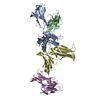 1efxS S: Starting model for refinement C: citing same article ( |
|---|---|
| Similar structure data |
- Links
Links
- Assembly
Assembly
| Deposited unit | 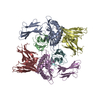
| ||||||||
|---|---|---|---|---|---|---|---|---|---|
| 1 | 
| ||||||||
| 2 | 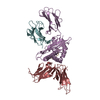
| ||||||||
| Unit cell |
|
- Components
Components
| #1: Protein | Mass: 31787.883 Da / Num. of mol.: 2 Source method: isolated from a genetically manipulated source Source: (gene. exp.)  Homo sapiens (human) / Gene: HLA-C, HLAC / Plasmid: pET30 / Production host: Homo sapiens (human) / Gene: HLA-C, HLAC / Plasmid: pET30 / Production host:  #2: Protein | Mass: 11879.356 Da / Num. of mol.: 2 Source method: isolated from a genetically manipulated source Source: (gene. exp.)  Homo sapiens (human) / Gene: B2M, CDABP0092, HDCMA22P / Plasmid: pET30 / Production host: Homo sapiens (human) / Gene: B2M, CDABP0092, HDCMA22P / Plasmid: pET30 / Production host:  #3: Protein/peptide | Mass: 1034.213 Da / Num. of mol.: 2 / Source method: obtained synthetically / Source: (synth.) synthetic construct (others) / References: UniProt: P68431*PLUS #4: Protein | Mass: 22406.029 Da / Num. of mol.: 2 Source method: isolated from a genetically manipulated source Source: (gene. exp.)  Homo sapiens (human) / Gene: KIR2DL2, CD158B1, NKAT6 / Plasmid: pET30 / Production host: Homo sapiens (human) / Gene: KIR2DL2, CD158B1, NKAT6 / Plasmid: pET30 / Production host:  Has protein modification | Y | |
|---|
-Experimental details
-Experiment
| Experiment | Method:  X-RAY DIFFRACTION / Number of used crystals: 1 X-RAY DIFFRACTION / Number of used crystals: 1 |
|---|
- Sample preparation
Sample preparation
| Crystal | Density Matthews: 2.2 Å3/Da / Density % sol: 44.07 % |
|---|---|
| Crystal grow | Temperature: 293 K / Method: vapor diffusion, hanging drop Details: 0.2 M Sodium tartrate dibasic dihydrate and 20% w/v PEG 3350 |
-Data collection
| Diffraction | Mean temperature: 100 K / Serial crystal experiment: N |
|---|---|
| Diffraction source | Source:  SYNCHROTRON / Site: SYNCHROTRON / Site:  Australian Synchrotron Australian Synchrotron  / Beamline: MX2 / Wavelength: 0.954 Å / Beamline: MX2 / Wavelength: 0.954 Å |
| Detector | Type: ADSC QUANTUM 315 / Detector: CCD / Date: Oct 12, 2014 |
| Radiation | Protocol: SINGLE WAVELENGTH / Monochromatic (M) / Laue (L): M / Scattering type: x-ray |
| Radiation wavelength | Wavelength: 0.954 Å / Relative weight: 1 |
| Reflection | Resolution: 3→50 Å / Num. obs: 20697 / % possible obs: 97 % / Redundancy: 4 % / Net I/σ(I): 4.6 |
| Reflection shell | Resolution: 3→3.12 Å / Redundancy: 3.8 % / Num. unique obs: 2015 / % possible all: 90.5 |
- Processing
Processing
| Software |
| |||||||||||||||||||||||||||||||||||||||||||||||||||||||||||||||||||||||||||||||||||||||||||||||||||||||||||||||||||||||||||||||||||||||||||||||||||||||||||||||||||||||||||||||||||||||||||||||||||||||||||||||||||||||||||||||||
|---|---|---|---|---|---|---|---|---|---|---|---|---|---|---|---|---|---|---|---|---|---|---|---|---|---|---|---|---|---|---|---|---|---|---|---|---|---|---|---|---|---|---|---|---|---|---|---|---|---|---|---|---|---|---|---|---|---|---|---|---|---|---|---|---|---|---|---|---|---|---|---|---|---|---|---|---|---|---|---|---|---|---|---|---|---|---|---|---|---|---|---|---|---|---|---|---|---|---|---|---|---|---|---|---|---|---|---|---|---|---|---|---|---|---|---|---|---|---|---|---|---|---|---|---|---|---|---|---|---|---|---|---|---|---|---|---|---|---|---|---|---|---|---|---|---|---|---|---|---|---|---|---|---|---|---|---|---|---|---|---|---|---|---|---|---|---|---|---|---|---|---|---|---|---|---|---|---|---|---|---|---|---|---|---|---|---|---|---|---|---|---|---|---|---|---|---|---|---|---|---|---|---|---|---|---|---|---|---|---|---|---|---|---|---|---|---|---|---|---|---|---|---|---|---|---|---|
| Refinement | Method to determine structure:  MOLECULAR REPLACEMENT MOLECULAR REPLACEMENTStarting model: 1EFX Resolution: 3.01→32.321 Å / SU ML: 0.64 / Cross valid method: FREE R-VALUE / σ(F): 1.34 / Phase error: 37.45
| |||||||||||||||||||||||||||||||||||||||||||||||||||||||||||||||||||||||||||||||||||||||||||||||||||||||||||||||||||||||||||||||||||||||||||||||||||||||||||||||||||||||||||||||||||||||||||||||||||||||||||||||||||||||||||||||||
| Solvent computation | Shrinkage radii: 0.9 Å / VDW probe radii: 1.11 Å | |||||||||||||||||||||||||||||||||||||||||||||||||||||||||||||||||||||||||||||||||||||||||||||||||||||||||||||||||||||||||||||||||||||||||||||||||||||||||||||||||||||||||||||||||||||||||||||||||||||||||||||||||||||||||||||||||
| Refinement step | Cycle: LAST / Resolution: 3.01→32.321 Å
| |||||||||||||||||||||||||||||||||||||||||||||||||||||||||||||||||||||||||||||||||||||||||||||||||||||||||||||||||||||||||||||||||||||||||||||||||||||||||||||||||||||||||||||||||||||||||||||||||||||||||||||||||||||||||||||||||
| Refine LS restraints |
| |||||||||||||||||||||||||||||||||||||||||||||||||||||||||||||||||||||||||||||||||||||||||||||||||||||||||||||||||||||||||||||||||||||||||||||||||||||||||||||||||||||||||||||||||||||||||||||||||||||||||||||||||||||||||||||||||
| LS refinement shell |
| |||||||||||||||||||||||||||||||||||||||||||||||||||||||||||||||||||||||||||||||||||||||||||||||||||||||||||||||||||||||||||||||||||||||||||||||||||||||||||||||||||||||||||||||||||||||||||||||||||||||||||||||||||||||||||||||||
| Refinement TLS params. | Method: refined / Refine-ID: X-RAY DIFFRACTION
| |||||||||||||||||||||||||||||||||||||||||||||||||||||||||||||||||||||||||||||||||||||||||||||||||||||||||||||||||||||||||||||||||||||||||||||||||||||||||||||||||||||||||||||||||||||||||||||||||||||||||||||||||||||||||||||||||
| Refinement TLS group |
|
 Movie
Movie Controller
Controller



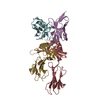
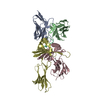
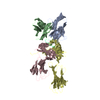
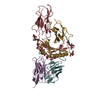
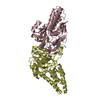



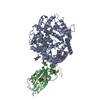
 PDBj
PDBj













